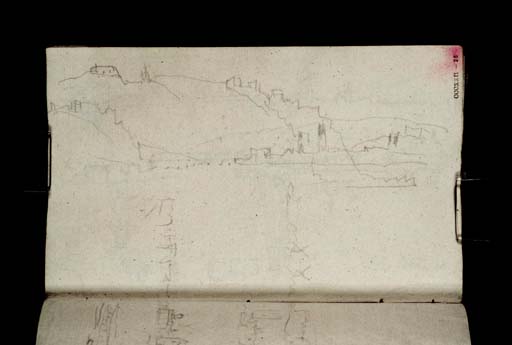Joseph Mallord William Turner Views of Ehrenbreitstein and Coblenz from the River Rhine 1833
Image 1 of 2
Joseph Mallord William Turner,
Views of Ehrenbreitstein and Coblenz from the River Rhine
1833
Joseph Mallord William Turner 1775–1851
Folio 25 Recto:
Views of Ehrenbreitstein and Coblenz from the River Rhine 1833
D32590
Turner Bequest CCCXXII 26
Turner Bequest CCCXXII 26
Pencil on white laid paper, 105 x 170 mm
Partial watermark: hindquarters and tail of unicorn
Inscribed by John Ruskin in red ink ‘26’ top right, ascending vertically (smudged and faint)
Stamped in black ‘CCCXXII – 26’ top right, ascending vertically
Partial watermark: hindquarters and tail of unicorn
Inscribed by John Ruskin in red ink ‘26’ top right, ascending vertically (smudged and faint)
Stamped in black ‘CCCXXII – 26’ top right, ascending vertically
Accepted by the nation as part of the Turner Bequest 1856
References
1909
A.J. Finberg, A Complete Inventory of the Drawings of the Turner Bequest, London 1909, vol.II, p.1036, CCCXXII 26, as ‘Ehrenbreitstein (?)’.
1978
Agnes von der Borch, Studien zu Joseph Mallord William Turners Rheinreisen (1817–1844) (Ph.D thesis, Rheinischen Friedrich-Wilhelms-Universität, Bonn 1972), Bonn 1978, p.87, as Ehrenbreitstein view, p.93, as unspecified Rhine subject, pp.97, 162 note 237, as among ‘Moselbrücke’ subjects ‘von Osten and Westen’, p.178 no.74, as ‘Ehrenbreitstein von Nordwesten. Unten: Blick stromaufwärts auf Ehrenbreitstein und Koblenz’.
The page was initially used horizontally for two related outline views, which effectively overlap entirely. As Finberg tentatively suggested1 and German art historian Agnes von der Borch confirmed,2 the subject is Ehrenbreitstein, the imposing complex overlooking the River Rhine opposite its confluence with the Mosel at Coblenz (Koblenz), looking south up the Rhine itself. One sketch shows both the skyline of the city and the high fortress, while the other shows more of the latter on a larger scale.
There is a view west up the Mosel from opposite Ehrenbreitstein on folio 22 verso (D32585; CCCXXII 23a), under which numerous drawings from other occasions of the city and the Balduinbrücke crossing are noted. As set out in its Introduction, this sketchbook covers Turner’s homeward route from Augsburg north-westwards to Rotterdam (see under folios 1 verso and 14 recto respectively; D32543, D32568; CCCXXII 2a, 15). Travelling back down the familiar Rhine, he worked in somewhat randomly from both ends, interspersing identifiable subjects with less distinctive renderings of towns, castles and the landscape.
Turner’s attention was always more engaged by the bulky profile of Ehrenbreitstein itself, often seen from the city’s Rhine waterfront. In the present book, see also folios 50 recto and verso, 53 recto and verso and 54 recto (D32638–D32639, D32643–D32645; CCCXXII 51, 51a, 54, 54a, 55). He had drawn it from near and far on the outward leg of the present tour, in the Brussels up to Manheim – Rhine sketchbook (Tate D29637, D29664–D29665, D29676, D29678, D29687, D29688, D29727, D29748; Turner Bequest CCXCVI 21, 34a, 35, 41a, 42a, 47, 47a, 67a, 78); compare in particular D29676.
Sketchbooks from other tours include many pencil studies: 1817: Waterloo and Rhine and Rhine (Tate; Turner Bequest CLX, CLXI); 1824: Rivers Meuse and Moselle and Trèves and Rhine (CCXVI, CCXVIII; the latter also in watercolour); 1835: Prague, Nuremberg, Frankfurt and Rhine (CCCIV); 1839: First Mossel and Oxford, Trèves to Cochem and Coblenz to Mayence and Cochem to Coblenz – Home (CCLXXXIX, CCXC, CCXCI); 1840: Würzburg, Rhine and Ostend (CCCIII); 1841: Bern, Heidelberg and Rhine (CCCXXVI).
There are also various pencil drawings on separate Turner Bequest sheets, colour studies on blue paper associated with the 1839 tour (Tate D20261, D24804, D24809, D24833; Turner Bequest CCXXII B, CCLIX 239, 244, 268; and National Gallery of Scotland, Edinburgh3), and in colour on grey from 1840 (D28957, D28979; CCXCII 10, 32). A series of more atmospheric colour studies on white paper followed in 1841 (D35863, D36138, D36166, D36177, D36186, D36206, D40181; CCCLXIV 26, 285, 309, 319, 328, 346, and 328a; and private collection4).
There are two finished watercolours of 1817 (Fogg Art Museum, Cambridge, Massachusetts;5 currently untraced6), 1819–20 (Bury Art Gallery),7 engraved in 1824 (Tate impression: T06067) and 1828 (T06135–T06136, T06630), and about 1832 (also at Bury),8 engraved in the year of the present tour (T04623–T04624, T06148). Another watercolour, possibly of 1840, is untraced.9 In terms of finished treatments the theme culminated in a vignette watercolour (National Gallery of Scotland)10 illustrating Thomas Campbell’s poem ‘Ode to the Germans’, engraved in 1837 (Tate T04784), and the major oil painting The Bright-Stone of Honour (Ehrenbreitstein) and Tomb of Marceau, from Byron's ‘Childe Harold’, exhibited in 1835 (private collection)11 and engraved in 1845, and again in 1859 (T06343).
Below the Ehrenbreitstein views on the present page, at right-angles towards the gutter are two slight continuations from subsequent river views of Rotterdam on folio 24 verso opposite (D32589; CCCXXII 25a).
Matthew Imms
November 2019
How to cite
Matthew Imms, ‘Views of Ehrenbreitstein and Coblenz from the River Rhine 1833 by Joseph Mallord William Turner’, catalogue entry, November 2019, in David Blayney Brown (ed.), J.M.W. Turner: Sketchbooks, Drawings and Watercolours, Tate Research Publication, March 2023, https://www


